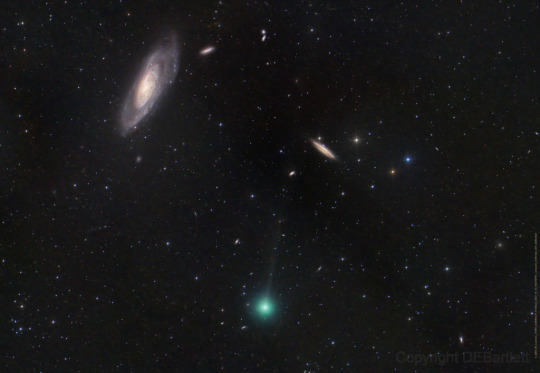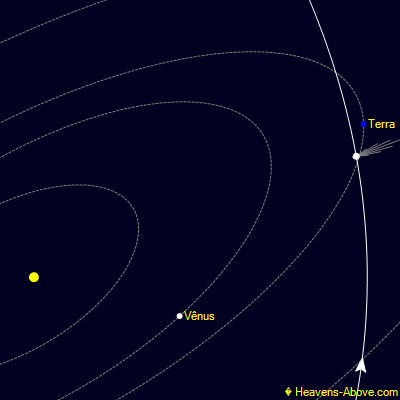#C/2023 H2 (Lemmon)
Text

Comet Lemmon © Dan Bartlett
#comet#comet lemmon#space#nasa#astrophotography#stars#c/2023 h2#night sky#galaxy#planet#universe#astronomy#solar system#cosmos
877 notes
·
View notes
Text
New Comet C/2023 H2 Lemmon by Giuseppe Pappa
youtube
Long-period comet C/2023 H2 (Lemmon) was discovered on April 23, 2023, as part of a star survey conducted with the 1.5-meter telescope at Mount Lemmon Observatory. The comet has an elongated orbit with an eccentricity close to unity. At perihelion it approaches the Sun at a distance of 0.89 AU. e., at aphelion it moves away from it at a distance of 490.7 a. e. With the size of the semi-major axis of the orbit 245.8 a. That is, the comet's orbital period around the Sun is about 3850 years. The last perihelion passage took place on October 29, 2023.
After comet C/2023 H2 (Lemmon) passes perihelion on the night of November 10-11 universal time, it will approach the Earth at a distance of about 29 million km. At this moment, the comet will be in the constellation Hercules, which will be located quite high above the horizon in the western part of the night sky.
Info by Wikipedia: https://ru.wikipedia.org/wiki/C/2023_...)
Camera by Giuseppe Pappa Source
link: https://www.facebook.com/groups/56439...
Music by Carry Kaeterry @carrykaeterry
Track «Dragonfly» • «One look via Portal» album by Carry ...
Bandcamp: https://carrykaeterry.bandcamp.com/tr...
Video editing by pictuREflection @pictuREflection
0 notes
Photo

2023 October 20
Galaxies and a Comet
Image Credit & Copyright: Dan Bartlett
Explanation: Galaxies abound in this sharp telescopic image recorded on October 12 in dark skies over June Lake, California. The celestial scene spans nearly 2 degrees within the boundaries of the well-trained northern constellation Canes Venatici. Prominent at the upper left 23.5 million light-years distant is big, beautiful spiral galaxy NGC 4258, known to some as Messier 106. Eye-catching edge-on spiral NGC 4217 is above and right of center about 60 million light-years away. Just passing through the pretty field of view is comet C/2023 H2 Lemmon, discovered last April in image data from the Mount Lemmon Survey. Here the comet sports more of a lime green coma though, along with a faint, narrow ion tail stretching toward the top of the frame. This visitor to the inner Solar System is presently less than 7 light-minutes away and still difficult to spot with binoculars, but it's growing brighter. Comet C/2023 H2 Lemmon will reach perihelion, its closest point to the Sun, on October 29 and perigee, its closest to our fair planet, on November 10 as it transitions from morning to evening northern skies.
∞ Source: apod.nasa.gov/apod/ap231020.html
88 notes
·
View notes
Text
A comet discovered earlier this year is performing above expectations, and is currently well-placed in the dusk sky. We’re talking about Comet C/2023 H2 Lemmon, moving up the charts now at magnitude +8 and brightening.
The first half of November is the best time to catch comet H2 Lemmon. The comet will really be truckin,’ moving at nine degrees a day at closest approach around November 10th. That’s about half an angular degree or the diameter of a Full Moon every 90 minutes, a motion versus the stellar background that should be easily discernible after following the comet for about 10 minutes. The comet starts off low to the northwest at dusk for northern hemisphere observers, before vaulting up high through the constellation Hercules into Aquila by mid-month.
0 notes
Text
Novembro de 2023

03: Júpiter (mag -2.9) em oposição
03: Lua passa a 1°24' de Pollux (mag 1.2)
04: Saturno termina movimento retrógrado
05: Lua Quarto Minguante
06: Lua passa a 4°12' de Regulus (mag 1.4)
06: Vênus em conjunção com a estrela Zavijava
09: Lua passa a 1°0' de Vênus (mag -4.4)
09: Vênus em conjunção com a fina Lua Minguante
10: Cometa C/2023 H2 (Lemmon) faz sua aproximação mais próxima da Terra
11: Lua passa a 2°24' de Spica (mag 1.0)
13: Lua Nova
13: Urano (mag 5.6) em oposição
14: Lua passa a 1°37' de Mercúrio (mag -0.4) e depois a 0°54' de Antares (mag 1.1)
14: Mercúrio em conjunção com a finíssima Lua Crescente
16: Mercúrio em conjunção com a estrela Antares
16: Mercúrio (mag -0.4) passa a 2°30' de Antares (mag 1.1)
17-18: Chuva de Meteoros Leonídeas
18: Marte em conjunção com o Sol
18: Vênus em conjunção com a estrela Porrima
20: Lua Quarto Crescente
20: Lua passa a 2°42' de Saturno (mag 0.8)
20: Saturno em conjunção com a Lua Quarto Crescente
21-22: Chuva de Meteoros Alpha Monocerotídeas
24: Júpiter em conjunção com a Lua Crescente Gibosa
25: Lua passa a 2°48' de Júpiter (mag -2.8)
27: Lua Cheia
27: Lua passa a 1°6' das Plêiades (mag 1.2)
28: Vênus (mag -4.2) passa a 3°54' de Spica (mag 1.0)
29: Vênus em conjunção com a estrela Spica

10 de Novembro de 2023: Cometa C/2023 H2 (Lemmon) faz sua aproximação mais próxima da Terra

Chuva de meteoros Leonídeas de 2023 ocorrerá em 17 e 18 de novembro:
A chuva de meteoros Leonídeas ocorrerá na madrugada da sexta, 17 de novembro; e também na madrugada do sábado, 18 de novembro de 2023.
Historicamente, as Leonídeas são consideradas a maior tempestade de meteoros dos tempos modernos! Essa é a penúltima chuva de meteoros mais intensa do ano!
O horário recomendado para iniciar a observação dessa chuva de meteoros será das 3h da madrugada até o amanhecer da sexta, 17 de novembro de 2023. Assim como na madrugada seguinte, das 3h da madrugada até o amanhecer do sábado, 18 de novembro de 2023. (Horário de Brasília – UTC-3)
A constelação de Leão – que dá nome a essa chuva de meteoros – será visível à Leste, sentido onde o Sol nasce, das 3h da madrugada até o amanhecer. Portanto, a constelação ficará no céu por quase toda a madrugada. (Horário de Brasília – UTC-3)
É nessa constelação que se localiza o radiante – ponto no céu de onde parecem surgir os meteoros. São estimados uma média de 15 meteoros por hora para a chuva de meteoros Leonídeas!
0 notes
Text

APOD October 20, 2023
Galaxies and a Comet
Galaxies abound in this sharp telescopic image recorded on October 12 in dark skies over June Lake, California. The celestial scene spans nearly 2 degrees within the boundaries of the well-trained northern constellation Canes Venatici. Prominent at the upper left 23.5 million light-years distant is big, beautiful spiral galaxy NGC 4258, known to some as Messier 106. Eye-catching edge-on spiral NGC 4217 is above and right of center about 60 million light-years away. Just passing through the pretty field of view is comet C/2023 H2 Lemmon, discovered last April in image data from the Mount Lemmon Survey. Here the comet sports more of a lime green coma though, along with a faint, narrow ion tail stretching toward the top of the frame. This visitor to the inner Solar System is presently less than 7 light-minutes away and still difficult to spot with binoculars, but it's growing brighter. Comet C/2023 H2 Lemmon will reach perihelion, its closest point to the Sun, on October 29 and perigee, its closest to our fair planet, on November 10 as it transitions from morning to evening northern skies.
©Dan Bartlett
1 note
·
View note
Text

Comet Lemmon 2023 © Fritz Hemut Hemmerich
#comet lemmon#comet#space#astrophotography#nasa#solar system#stars#night sky#astronomy#universe#planet#cosmos#galaxy#C/2023 h2
908 notes
·
View notes